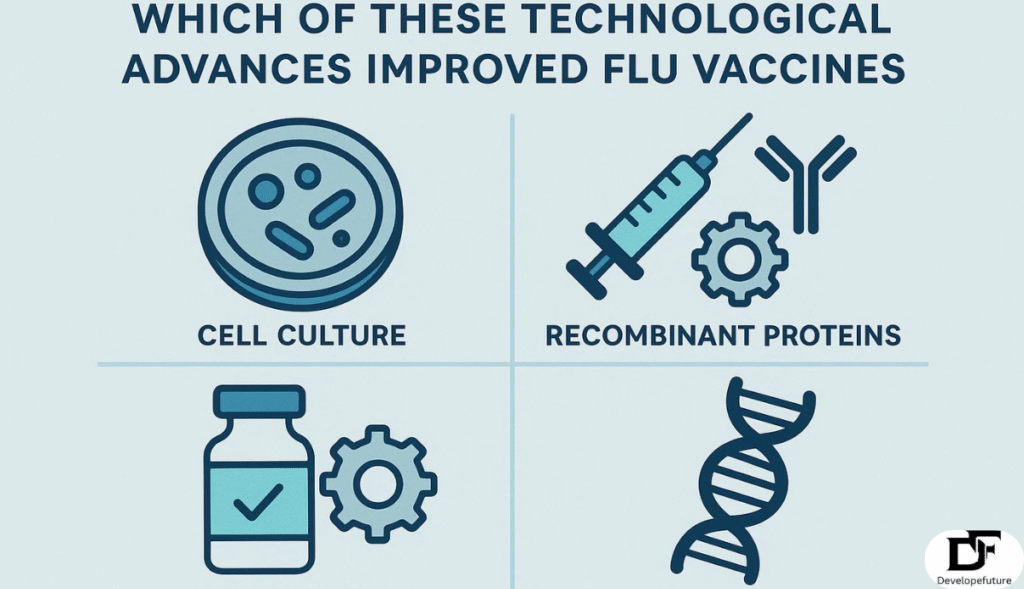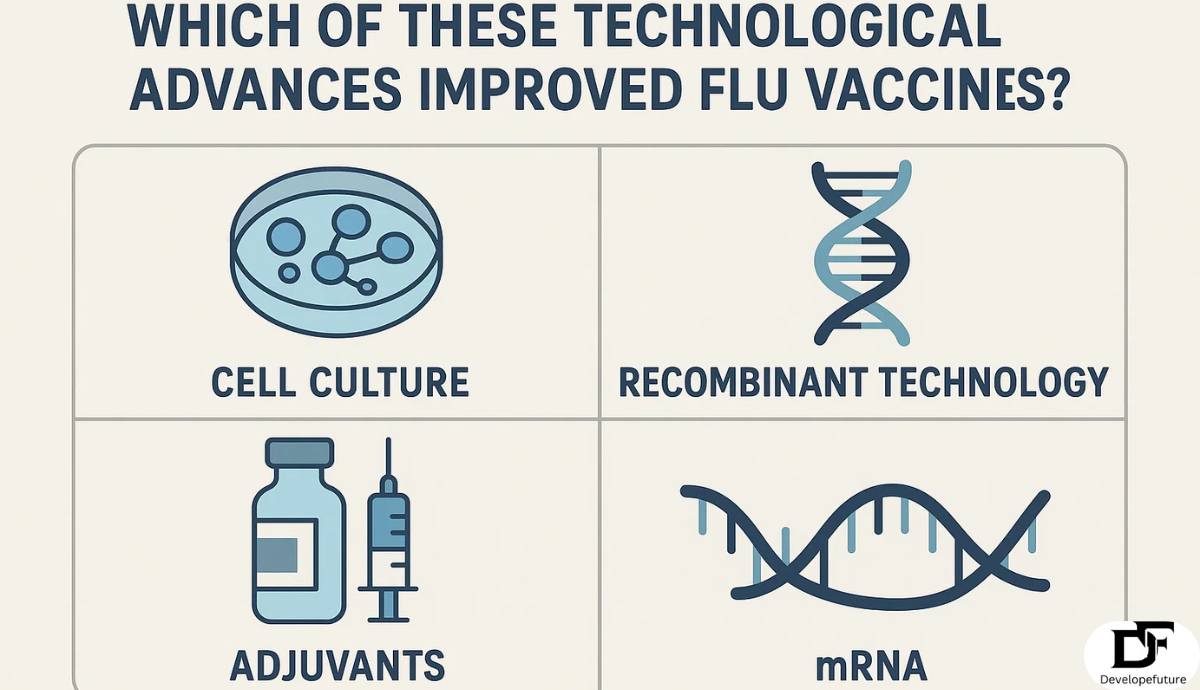Flu vaccines have long been a cornerstone of public health. It is protecting millions of people from seasonal influenza outbreaks. Over the decades, these vaccines have undergone many transformations. It is moving from traditional production methods to modern technological breakthroughs. Each new step in science has contributed to making flu vaccines more effective. It is making it accessible and faster to produce.
This question is essential, especially in a world where viruses evolve quickly. Advances in biotechnology, genetic research. Digital tools have significantly reshaped the way vaccines are designed and delivered. These improvements have not only increased vaccine effectiveness. But also prepared scientists to respond faster to future pandemics.
Here, we will examine the significant technological advancements. That has improved flu vaccines. Also including cell-based production, recombinant DNA technology, and mRNA platforms. And the application of artificial intelligence in vaccine development. These advances highlight how science and technology together are making vaccines. More reliable and accessible for the global population.
Table of Contents
Background
The earliest flu vaccines were developed in the 1940s. That uses a method which involves growing influenza viruses in chicken eggs. This approach became the global standard for decades. And it saved millions of lives by providing seasonal protection. It had limitations, including long production times. It reduced effectiveness when the virus mutated in eggs.
As flu viruses constantly change, public health experts realized the need for innovation. The egg-based process sometimes produced vaccines. That was less effective against circulating strains, creating gaps in protection. These challenges encouraged researchers to explore alternative production methods. Also, advanced technologies could deliver more reliable vaccines.

Recent Advances with Flu Vaccines
One of the most significant improvements has been the shift to cell-based vaccine production. Instead of using eggs, scientists now grow viruses in mammalian cells, such as MDCK cells. This process reduces the chance of mutations. It speeds up production and increases consistency in vaccine effectiveness. It has become a vital step. That is forward in addressing the shortcomings of egg-based vaccines.
Another major advancement is the development of recombinant DNA technology. By using genetic sequences to create flu proteins in the lab. Vaccines can be produced without handling live viruses. This method is faster, safer, and allows large-scale manufacturing. Recombinant flu vaccines, such as Flublok. It highlights how genetic engineering has revolutionized vaccine development.
Beyond production methods, mRNA vaccine technology has emerged as a groundbreaking innovation. Widely recognized during the COVID-19 pandemic, mRNA vaccines are now being tested for flu. They provide flexibility, faster updates for new strains, and strong immune responses. Together, these recent advances show how science is rapidly modernizing flu vaccine technology.
Artificial intelligence and big data analytics also play an important role. Predicting flu strains has always been challenging. But AI models now analyze global data to forecast outbreaks with greater accuracy. This allows scientists to design vaccines better matched to seasonal flu patterns. It is improving effectiveness and reducing missed targets.
Long-Term Goals to Improve Flu Vaccines
A major long-term goal in flu vaccine research is the development of a universal flu vaccine. Current vaccines require annual updates. But a universal vaccine would provide long-lasting protection against multiple flu strains. Scientists are targeting conserved viral regions. That changes less frequently, aiming to create broader immunity for global populations.
Another long-term goal is to expand the use of adjuvants in flu vaccines. Adjuvants, such as MF59 and AS03, boost immune responses. It makes vaccines more effective, especially for older adults. By enhancing immunity with lower doses. Adjuvants improve vaccine efficiency and make global distribution more practical in large populations.
Looking ahead, researchers are also working on nanoparticle-based vaccines and advanced delivery systems. These methods could make vaccines easier. To administer and be more effective at stimulating the immune system. If successful, they would represent a breakthrough in accessibility and long-term prevention strategies.
Global collaboration and digital health tools will play a critical role in flu vaccine development. By combining AI-driven predictions, genomic research, and international cooperation, the future of flu vaccines will be faster, more reliable, and more universal than ever before.

Shift from Egg-Based to Cell-Based Vaccine Production
Flu vaccines were produced using chicken eggs, a process that has been in place since the 1940s. While effective, this method is slow. Labor-intensive and can sometimes reduce the vaccine’s effectiveness due to changes in the virus when it adapts to eggs. These challenges made it clear. That innovation was needed to make vaccines faster and more precise.
Cell-based vaccine production was a breakthrough. Instead of relying on eggs, scientists now grow. The flu viruses in cultured mammalian cells. Such as Madin-Darby Canine Kidney (MDCK) cells. This process shortens production time. It reduces the risk of mutations during growth. And provides a more consistent vaccine. It is a prime example of how technological advances improved flu vaccines by addressing long-standing limitations.
Recombinant DNA Technology for Vaccine Design
Another major improvement came with recombinant DNA technology. This technique allows scientists to produce flu vaccines without using the flu virus itself. Instead, they use genetic sequences to create viral proteins in controlled laboratory environments.
Recombinant vaccines are safer and quicker to produce. As they bypass the need for live viruses. For example, the FDA-approved recombinant flu vaccine, Flublok, is manufactured using this approach. This advancement demonstrates how genetic engineering ensures vaccines can be scaled up rapidly. While it maintains safety and effectiveness.

mRNA Vaccine Platforms and Their Influence
Although mRNA vaccines became widely known during the COVID-19 pandemic. Their application to influenza has been under research for years. Unlike traditional vaccines, mRNA vaccines use genetic instructions to teach cells. How to produce harmless viral proteins that trigger an immune response.
This technology allows for faster vaccine development. And can be updated quickly to match new flu strains. Clinical trials are ongoing to evaluate mRNA-based flu vaccines. Which could transform seasonal flu prevention. The flexibility of this platform is one of the most promising technological advances improving flu vaccines today.

Use of Artificial Intelligence and Big Data
Artificial intelligence and big data have also contributed to the improvement of flu vaccines. Predicting flu strains is a complex task, as the virus mutates rapidly. Experts relied on surveillance data and laboratory testing, but predictions were often uncertain.
AI-driven models now analyze vast amounts of global data, identifying patterns. That helps forecast which flu strains are most likely to circulate in the upcoming season. This allows scientists to design vaccines with greater accuracy. Big data also assists in monitoring vaccine effectiveness and distribution. It is ensuring better outcomes for public health.
Adjuvants to Enhance Vaccine Effectiveness
Adjuvants are substances added to vaccines to boost the immune response. In the case of flu vaccines, adjuvants such as MF59 and AS03 have been game-changing. They help the body produce a stronger and longer-lasting immunity. Especially in vulnerable populations like the elderly.
The inclusion of adjuvants means lower doses of the vaccine can still provide strong protection. making distribution more efficient. This advancement highlights another way. In which technological progress has improved the effectiveness and accessibility of flu vaccines worldwide.
Universal Flu Vaccine Research
One of the most ambitious goals in flu vaccine research is the development of a universal flu vaccine. Current vaccines need to be updated every year because flu viruses constantly mutate. New technologies are being applied to target conserved parts of the virus. That does not change frequently.
Using advanced molecular biology, structural biology, and nanotechnology, researchers are designing vaccines. That could provide long-term protection against multiple flu strains. While still in development, this innovation represents the future of flu prevention. And showcases how science continues to push boundaries.
FAQ’s
Why was egg-based flu vaccine production replaced by newer methods?
Egg-based production was slow and sometimes led to reduced effectiveness. Due to viral mutations during growth. It is leading to the adoption of cell-based and recombinant methods.
What is the role of recombinant DNA technology in flu vaccines?
Recombinant DNA technology allows scientists to create vaccines without using live flu viruses. It is making production faster, safer, and scalable.
How can mRNA vaccines improve flu prevention?
mRNA vaccines can be developed. And updated quickly to match new flu strains. It is offering flexibility and faster responses to changing viruses.
What role does artificial intelligence play in flu vaccine development?
AI helps predict which flu strains will dominate in upcoming seasons by analyzing global data. It is improving the accuracy of vaccine formulation.
What is a universal flu vaccine, and why is it important?
A universal flu vaccine would provide long-term protection against multiple flu strains. It is reducing the need for yearly updates and improving global health security.
Conclusion
Flu vaccines have improved tremendously thanks to technological advances. That has reshaped their production and design. From egg-based vaccines to cell-based and recombinant DNA methods. Science has found ways to overcome challenges and increase reliability. These innovations have paved the way for faster. It is safer and more effective for vaccines worldwide.
Such as mRNA platforms, AI-driven predictions, and the use of adjuvants have already shown remarkable potential. They ensure that seasonal flu vaccines can adapt quickly to viral changes. And provide strong protection across diverse populations. These steps are crucial in reducing hospitalizations and saving lives every year.
The long-term vision of a universal flu vaccine remains one of the most promising goals in medical science. With ongoing research in nanotechnology, structural biology, and global data-sharing, a future. Where flu vaccines offer long-lasting protection may soon become reality. These technological advances have not only improved flu vaccines. But also strengthened humanity’s defense against infectious diseases.

